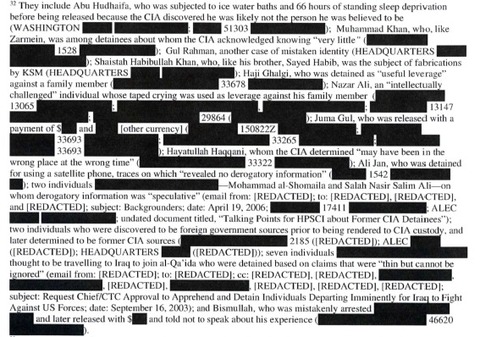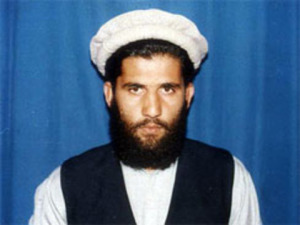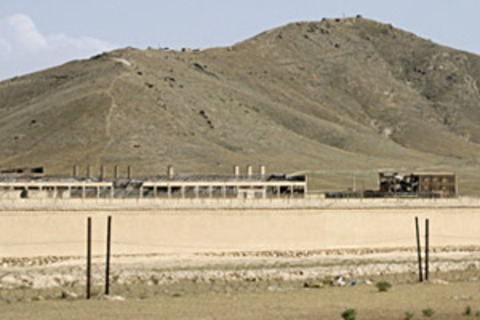What Is in the Senate Intelligence Committee Report on CIA Torture (Part I)
SPECIAL FEATURE, 22 Dec 2014
Tom Carter, WSWS – TRANSCEND Media Service
16 Dec 2014 – This is the first of three articles summarizing the contents of the unclassified executive summary of the US Senate Intelligence Committee’s 6,700-page report on the CIA torture program, released last week.
The US Senate Intelligence Committee Report on the Central Intelligence Agency’s “enhanced interrogation program” exposes the CIA as a globe-spanning enterprise of criminality, deceit, and violence—as well as rank incompetence, petty intriguing, and porno-sadistic depravity.
With the support of the political establishment in the US and its international accomplices, the CIA operates without accountability or restraint—lying, brutalizing, and bungling its way around the world in pursuit of the interests of American imperialism.
From a legal standpoint, the war crimes and crimes against humanity that are documented in the report warrant the immediate arrest, indictment and prosecution of every individual involved in the program, from the torturers themselves and their “outside contractors” all the way up to senior officials in the Bush and Obama administrations who presided over the program and subsequently attempted to cover it up. The Watergate scandal, which resulted in Nixon’s resignation, pales in comparison. However, the perpetrators remain at large and nobody has been held accountable.
The full committee study, which amounts to 6,700 pages and contains 38,000 footnotes, remains classified and has not been publicly released. The document published last week, at 525 pages and heavily redacted, is the executive summary. It was originally completed on December 13, 2012, but its publication was obstructed by the Obama administration for a further two years.
This article, the first of a series presented by the World Socialist Web Site, aims to provide a synopsis and analysis of the report.
The executive summary opens with a letter by Democratic senator Diane Feinstein, who chairs the Senate Intelligence Committee. The letter essentially reads as an apology for the CIA crimes documented in the report. “It is worth remembering the pervasive fear in late 2001 and how immediate the threat felt,” she writes, tendentiously recalling her personal memories of the September 11, 2001, attacks. “I can understand the CIA’s impulse to consider the use of every possible tool to gather intelligence and remove terrorists from the battlefield,” she continues, “and the CIA was encouraged by political leaders and the public to do whatever it could to prevent another attack.”
Feinstein’s introductory letter makes clear that her opposition to CIA torture is not fundamentally because is depraved and a war crime, but from the standpoint that it has not resulted in useful intelligence. When her committee launched its investigation in 2009, she wrote that its purpose was “to review the program and to shape detention and interrogation policies in the future.” In her letter, Feinstein cites the CIA’s own documents as evidence that the “enhanced interrogation” (i.e., torture) techniques “do not produce intelligence,” “will probably result in false answers,” and have historically proven to be ineffective.
The CIA’s “enhanced interrogation” program has its origins at the highest levels of the Bush administration following the September 11 attacks. As early as November 2001, the report states, “CIA officers had begun researching potential legal defenses for using interrogation techniques that were considered torture by foreign governments and a non-governmental organization.” In other words, the first step was to concoct a pseudo-legal justification for something that everyone knew was prohibited by international law, American law, and even the CIA’s own internal policies.
The Bush administration was likely concerned that public trials of the individuals suspected of involvement in the September 11 attacks would shed too much light on the American intelligence agencies’ long and sordid history of partnerships with groups such as Al Qaeda, and would perhaps lead to unpleasant questions being asked about what the those agencies knew in advance of the attacks. Instead, a plan was devised to round up all of these individuals and hold them incommunicado.
The conspiracy to implement the illegal program reached all the way up to the Oval Office. President Bush issued a memorandum in February 2002 stating that Common Article 3 of the Geneva Convention, “requiring humane treatment of individuals in a conflict, did not apply to al-Qa’ida or Taliban detainees.”
The Senate Intelligence Committee found that at least 119 individuals had been targeted by the program during its existence, contrary to the CIA’s claims that the number of individuals involved was “less than a hundred.” (This was one of a very long list of CIA lies documented in the report.) The committee found that at least 26 of those individuals (or 22 percent of the total) “did not meet the standard for detention”—that is, they were innocent victims.
At the beginning of the program, the CIA had no personnel trained in how to perform torture, so to implement the torture program, the agency retained two psychologists as outside contractors: “Dr. Grayson SWIGERT and Dr. Hammond DUNBAR.” These psychologists (identified by the New York Times and NBC News as Jim Mitchell and Bruce Jessen) had no field experience with respect to interrogation and had only prepared a research paper on the subject of how CIA agents could resist torture. Nevertheless, in 2006, “the value of the CIA’s base contract with the company formed by the psychologists with all options exercised was in excess of $180 million; the contractors received $81 million prior to the contract’s termination in 2009.”
Abu Zubaydah, a Saudi citizen and allegedly a low- or mid-ranking Al Qaeda figure, was among the first victims of the program. He was initially questioned by the Federal Bureau of Investigation (FBI), which provided him with medical care and established a rapport with him. Zubaydah cooperated with the FBI, identifying Khalid Shaykh Mohammad as the “mastermind” of the September 11, 2001, attacks and providing other information.
Abruptly, the CIA intervened and took over the interrogation of Zubaydah, demanding the exclusion of the FBI personnel who had been previously involved. The FBI, which is the criminal investigative agency belonging to the federal Department of Justice, apparently objected to this intervention.
The CIA’s openly declared strategy was to impose “learned helplessness” on Zubaydah through torture. But after taking custody of Zubaydah, the CIA agents responsible for his interrogation went on vacation, taking “time off for a break and to attend to personal matters” and leaving Zubaydah in isolation for 47 days. So much for the danger of imminent terrorist attacks!
In 2002, the CIA began meeting with top officials in the Bush administration to obtain authorization for torturing Zubaydah. The CIA insisted that its interrogation of Zubaydah take precedence over Zubaydah’s medical care, and even established a contingency plan for what should be done in the event that Zubaydah died while being tortured.
On July 24, 2002, Attorney General John Ashcroft directly authorized a number of torture techniques, including “attention grasp, walling, the facial hold, the facial slap (insult slap), cramped confinement, wall standing, stress positions, sleep deprivation, use of diapers, and use of insects.”
On July 26, 2002, Ashcroft expressly approved waterboarding. With the blessing of Ashcroft and other senior Bush administration officials, Zubaydah was tortured around the clock during the month of August 2002. By the end of the first week of the interrogations, the CIA determined that it was unlikely that Zubaydah would provide any useful information, but the torture continued anyway.
During waterboarding, internal CIA documents described Zubaydah as “hysterical” and “distressed to the level that he was unable to effectively communicate.” Waterboarding Zubaydah “resulted in immediate fluid intake and involuntary leg, chest and arm spasms” and “hysterical pleas.” At least once during waterboarding, Zubaydah “became completely unresponsive, with bubbles rising through his open, full mouth.” During Zubaydah’s torture, he lost his left eye. The CIA subsequently destroyed video evidence of these interrogations to prevent it from coming into the hands of investigators.
The Senate report confirms that the torture of Zubaydah did not result in any meaningful intelligence—but CIA headquarters falsely insisted to the Bush administration at the time that the torture of Zubaydah was effective and was “producing meaningful results,” and that it “should be used as a template for future interrogation of high value captives.” The CIA also falsely claimed that the information that was obtained through the FBI’s successful interviews of Zubaydah was actually the fruit of its own “enhanced interrogation” strategies.
In July of this year, the European Court of Human Rights awarded Zubaydah €100,000 in damages and €30,000 in costs against the Polish government, which had allowed the CIA to torture him on its territory.
In 2002, the CIA established a dedicated torture facility codenamed DETENTION SITE COBALT. (In one of many examples of the gratuitous redactions in the report, the fact that the COBALT facility is located in Afghanistan was redacted, even though that fact is available through other sources.)
The COBALT facility, also known as the “Salt Pit,” was one of the many “black site” torture facilities used by the CIA during the course of the program. Its windows “were blacked out and detainees were kept in total darkness…. While in their cells, detainees were shackled to the wall and given buckets for human waste. Four of the twenty cells at the facility included a bar across the top of the cell. Later reports describe detainees being shackled to the bar with their hands above their heads, forcing them to stand, and therefore not allowing the detainees to sleep.”
In November 2002, Gul Rahman died at the COBALT facility. Rahman was innocent—a case of “mistaken identity.” He was traveling to Islamabad for a medical checkup when he was kidnapped and murdered by the CIA, which did not even bother to notify his wife and four children of his death. No one was ever charged with a crime in connection with Rahman’s death.
According to the report, Rahman was “shackled to the wall of his cell in a position that required the detainee to rest on the bare concrete floor,” and the warden “had ordered that Rahman’s clothing be removed when he had been judged to be uncooperative during an earlier interrogation.” In other words, he was stripped for the purpose of humiliating him.
“The next day, the guards found Gul Rahman’s dead body.” The cause of death was determined to be hypothermia, “in part from having been forced to sit on the bare concrete floor without pants.” Rahman’s corpse was also discovered to be covered with bruises and abrasions.
The CIA officer assigned as warden of the COBALT facility was someone who had “little to no experience with interrogating or handling prisoners,” according to the report. A previous CIA supervisor had determined that the warden lacked “honesty, judgment, and maturity.” However, four months after Rahman’s death, the CIA recommended that the warden receive a “cash award” of $2,500 for his “consistently superior work.”
Other torture techniques in use at the COBALT facility included “standing sleep deprivation in which a detainee’s arms were shackled above his head, nudity, dietary manipulation, exposure to cold temperatures, cold showers, ‘rough takedowns,’ and, in at least two instances, the use of mock executions.” At the COBALT facility, “CIA officers (including personnel not trained in interrogation) could, at their discretion, strip a detainee naked, shackle him in the standing position for up to 72 hours, and douse the detainee repeatedly with cold water.”
Beginning in 2002, the CIA began providing special “interrogation training” (torture training) to selected officers. The Senate Intelligence Committee noted that individuals who were selected by the CIA as torturers included “inexperienced, marginal, underperforming” officers from other assignments and “individuals who, among other issues, had engaged in inappropriate detainee interrogations, had workplace anger management issues, and had reportedly admitted to sexual assault.”
In other words, the CIA was deliberately seeking out, cultivating, and advancing psychopaths within its ranks.
Meanwhile, the network of secret CIA torture facilities continued to grow. The COBALT facility held “a total of 64 detainees during the period of its operation between September 2002 and [redacted] 2004,” while “DETENTION SITE GRAY held eight detainees…DETENTION SITE ORANGE…held 34 detainees…and DETENTION SITE BROWN…held 12 detainees” during the period of their operation.
The torture of Abd al-Rahim Al-Nashiri, who was alleged to have been involved in the USS Cole bombing and the 1998 East Africa US Embassy bombings, is a representative case. The torture of Al-Nashiri included placing “a pistol near al-Nashiri’s head and operat[ing] a cordless drill near al-Nashiri’s body.”
Besides waterboarding, other techniques included “slapping al-Nashiri multiple times on the back of the head during interrogations; implying that his mother would be brought before him and sexually abused; blowing cigar smoke in al-Nashiri’s face; giving al-Nashiri a forced bath using a stiff brush; and using improvised stress positions that caused cuts and bruises resulting in the intervention of a medical officer, who was concerned that al-Nashiri’s shoulders would be dislocated using the stress positions.”
At one point, al-Nashiri went on a hunger strike, to which the CIA responded by force-feeding him “rectally.”
Another detainee, as a result of repeated waterboarding, developed an abdomen that “was somewhat distended and he expressed water when the abdomen was pressed.” CIA documents indicate that “[i]n the new technique we are basically doing a series of near drownings.”
The most infamous of the torture techniques described in the report is “rectal rehydration, without evidence of medical necessity.” CIA documents quote one medical officer who described the technique as follows: “you get a tube up as far as you can, then open the IV wide. No need to squeeze the bag—let gravity do the work.”
One detainee who was subjected to this procedure was later “diagnosed with chronic hemorrhoids, an anal fissure, and symptomatic rectal prolapse.” In other words, his large intestine was protruding out of his body.
The report describes how detainee Majid Khan’s “lunch tray, consisting of hummus, pasta with sauce, nuts, and raisins was ‘pureed’ and rectally infused.” This procedure was repeated a number of times for no apparent medical reason.
In response to this treatment, Majid Khan repeatedly attempted to kill himself, including “attempting to cut his wrist on two occasions, an attempt to chew into his arm at the inner elbow, an attempt to cut a vein in the top of his foot, and an attempt to cut into his skin at the elbow joint using a filed toothbrush.”
A man “had to stand up for five days straight and answer questions;” a man was “forced to strip naked and stand in front of a female interrogator;” a man was “subjected to baths in which ice water was used;” a man was forced to stand on a broken limb until the leg swelled up; a man was forced to stand up for 56 hours straight, until he began to hallucinate; a man was deprived of sleep “for a total of 138.5 hours” in a row; men were subjected to loud music around the clock; a broomstick was placed behind the knees of a man in a stress position, recalling the techniques employed by the medieval Inquisition.
In another episode, “water dousing was used on Abu Hazim, a cloth covered Abu Hazim’s face, and [redacted] poured cold water directly on Abu Hazim’s face to disrupt his breathing. [The linguist] said that when Abu Hazim turned blue, Physician’s Assistant [redacted] removed the cloth so that Abu Hazim could breathe.”
CIA officers willfully ignored recommendations by doctors against the torture methods that were being employed and pressed ahead anyway, even when the person being tortured had no information to provide. Many of the men subjected to torture developed behavioral and psychological problems, including hallucinations, paranoia, insomnia, suicidal ideation, and other complications, with some suffering total breakdowns.
The report is not limited to torture, but depicts the CIA as engaged in what amounts to organized crime on a daily basis. In one episode, the political leadership of a country where a secret CIA torture facility was located “rejected the transfer” of certain detainees, apparently uncomfortable over the political ramifications of CIA torture taking place within its borders.
“The following month [redacted] provided [redacted]$ million to Country [redacted]’s [redacted] which officials, for Country [redacted] political leadership, indicated that Country [redacted] was now flexible with regard to the number of CIA detainees at the facility and when the facility would eventually be closed.” In other words, the CIA paid millions in cash bribes to keep the torture facility operational.
The CIA’s torture program was accompanied by constant turf-warring and factional maneuvering by the agency within the Bush administration. While the CIA provided information about its activities to its factional allies, it provided inaccurate information to everyone else or kept them in the dark entirely, dispensing information as a kind of patronage.
By the end of 2006, virtually all of the top officials in the Bush administration knew about the torture program, making them all accomplices in it. When President Bush was finally briefed about the program in April 2006, he “expressed discomfort” only with an “image of a detainee, chained to the ceiling, clothed in a diaper, and forced to go to the bathroom on himself.”
The CIA’s interrogation program did not, it appears, achieve anything at all from an intelligence or national security standpoint. With the country supposedly at risk of an imminent terrorist attack, the CIA at various times lost track of how many detainees it had.
The Senate Intelligence Committee report focuses on the CIA’s inept and mismanaged implementation the program, and there are definite political reasons behind this emphasis. Nevertheless, the CIA’s incompetence is a further reflection of the extent to which democratic norms—as well as professionalism and basic human decency—have disappeared from the internal machinery of the state, which is instead permeated through and through with criminality and corruption.
To be continued.
DISCLAIMER: The statements, views and opinions expressed in pieces republished here are solely those of the authors and do not necessarily represent those of TMS. In accordance with title 17 U.S.C. section 107, this material is distributed without profit to those who have expressed a prior interest in receiving the included information for research and educational purposes. TMS has no affiliation whatsoever with the originator of this article nor is TMS endorsed or sponsored by the originator. “GO TO ORIGINAL” links are provided as a convenience to our readers and allow for verification of authenticity. However, as originating pages are often updated by their originating host sites, the versions posted may not match the versions our readers view when clicking the “GO TO ORIGINAL” links. This site contains copyrighted material the use of which has not always been specifically authorized by the copyright owner. We are making such material available in our efforts to advance understanding of environmental, political, human rights, economic, democracy, scientific, and social justice issues, etc. We believe this constitutes a ‘fair use’ of any such copyrighted material as provided for in section 107 of the US Copyright Law. In accordance with Title 17 U.S.C. Section 107, the material on this site is distributed without profit to those who have expressed a prior interest in receiving the included information for research and educational purposes. For more information go to: http://www.law.cornell.edu/uscode/17/107.shtml. If you wish to use copyrighted material from this site for purposes of your own that go beyond ‘fair use’, you must obtain permission from the copyright owner.



